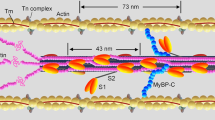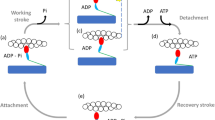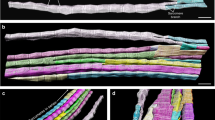Abstract
Muscle contraction is driven by the motor protein myosin II, which binds transiently to an actin filament, generates a unitary filament displacement or ‘working stroke’, then detaches and repeats the cycle. The stroke size has been measured previously using isolated myosin II molecules at low load, with rather variable results1,2,3,4, but not at the higher loads that the motor works against during muscle contraction. Here we used a novel X-ray-interference technique5,6 to measure the working stroke of myosin II at constant load7 in an intact muscle cell, preserving the native structure and function of the motor. We show that the stroke is smaller and slower at higher load. The stroke size at low load is likely to be set by a structural limit8,9; at higher loads, the motor detaches from actin before reaching this limit. The load dependence of the myosin II stroke is the primary molecular determinant of the mechanical performance and efficiency of skeletal muscle.
This is a preview of subscription content, access via your institution
Access options
Subscribe to this journal
Receive 51 print issues and online access
$199.00 per year
only $3.90 per issue
Buy this article
- Purchase on Springer Link
- Instant access to full article PDF
Prices may be subject to local taxes which are calculated during checkout


Similar content being viewed by others
References
Finer, J. T., Simmons, R. M. & Spudich, J. A. Single myosin molecule mechanics: piconewton forces and nanometre steps. Nature 368, 113–119 (1994)
Molloy, J. E. et al. Movement and force produced by a single myosin head. Nature 378, 209–212 (1995)
Metha, A. D. et al. Single molecule biomechanics with optical methods. Science 283, 1689–1695 (1999)
Kitamura, K., Tokunaga, M., Iwane, A. H. & Yanagida, T. A single myosin head moves along an actin filament with regular steps of 5.3 nanometres. Nature 397, 129–134 (1999)
Linari, M. et al. Interference fine structure and sarcomere length dependence of the axial X-ray pattern from active single muscle fibres. Proc. Natl Acad. Sci. USA 97, 7226–7231 (2000)
Piazzesi, G. et al. Mechanism of force generation by myosin heads in skeletal muscle. Nature 415, 659–662 (2002)
Piazzesi, G., Lucii, L. & Lombardi, V. The size and the speed of the working stroke of muscle myosin and its dependence on the force. J. Physiol. (Lond.) 545, 145–151 (2002)
Rayment, I. et al. Three-dimensional structure of myosin subfragment-1: a molecular motor. Science 261, 50–58 (1993)
Dominguez, R., Freyzon, Y., Trybus, K. M. & Cohen, C. Crystal structure of a vertebrate smooth muscle myosin motor domain and its complex with the essential light chain: visualisation of the pre-power stroke state. Cell 94, 559–571 (1998)
Huxley, H. E., Stewart, A., Sosa, H. & Irving, T. X-ray diffraction measurements of the extensibility of actin and myosin filaments in contracting muscle. Biophys. J. 67, 2411–2421 (1994)
Wakabayashi, K. et al. X-ray diffraction evidence for the extensibility of actin and myosin filaments during muscle contraction. Biophys. J. 67, 2422–2435 (1994)
Podolsky, R. J. Kinetics of muscular contraction: the approach to the steady state. Nature 188, 666–668 (1960)
Huxley, A. F. & Simmons, R. M. Proposed mechanism of force generation in striated muscle. Nature 233, 533–538 (1971)
Huxley, H. E. et al. Changes in the X-ray reflections from contracting muscle during rapid mechanical transients and their structural implications. J. Mol. Biol. 169, 469–506 (1983)
Irving, M., Lombardi, V., Piazzesi, G. & Ferenczi, M. A. Myosin head movements are synchronous with the elementary force-generating process in muscle. Nature 357, 156–158 (1992)
Piazzesi, G. et al. Changes in the X-ray diffraction pattern from single intact muscle fibres produced by rapid shortening and stretch. Biophys. J. 68, 92s–98s (1995)
Irving, M. et al. Conformation of the myosin motor during force generation in skeletal muscle. Nature Struct. Biol. 7, 482–485 (2000)
Huxley, H. E., Reconditi, M., Stewart, A. & Irving, T. What the higher order meridional reflections tell us. Biophys. J. 84, 139a (2003)
Dobbie, I. et al. Elastic bending and active tilting of myosin heads during muscle contraction. Nature 396, 383–387 (1998)
Linari, M. et al. The stiffness of skeletal muscle in isometric contraction and rigor: the fraction of myosin heads bound to actin. Biophys. J. 74, 2459–2473 (1998)
Huxley, A. F. & Tideswell, S. Filament compliance and tension transients in muscle. J. Muscle Res. Cell Motil. 17, 507–511 (1996)
Kushmerick, M. J. & Davies, R. E. The chemical energetics of muscle contraction. Proc. R. Soc. Lond. B 174, 315–353 (1969)
Sun, Y.-B., Hilber, K. & Irving, M. Effect of active shortening on the rate of ATP utilisation by rabbit psoas muscle fibres. J. Physiol. (Lond.) 531, 781–791 (2001)
Lombardi, V. & Piazzesi, G. The contractile response during steady lengthening of stimulated frog muscle fibres. J. Physiol. (Lond.) 431, 141–171 (1990)
Irving, T. C., Fischetti, R., Rosenbaum, G. & Bunker, G. B. Fibre diffraction using the BioCAT undulator beamline at the Advanced Photon Source. Nucl. Instrum. Methods Phys. Res. A 448, 250–254 (2000)
Boesecke, P., Diat, O. & Rasmussen, B. High-brilliance beamline at the European Synchrotron Radiation Facility. Rev. Sci. Instrum. 66, 1636–1638 (1995)
Phillips, W. C. et al. High-sensitivity CCD-based X-ray detector. J. Synchrotron Radiat. 9, 36–43 (2002)
Haselgrove, J. C. X-ray evidence for conformational changes in the myosin filaments of vertebrate striated muscle. J. Mol. Biol. 92, 113–143 (1975)
Acknowledgements
This work was supported by Ministero dell'Istruzione, dell'Università e della Ricerca, Telethon-945 (Italy), the National Institutes of Health (NIH, USA), the Medical Research Council (UK), the European Molecular Biology Laboratory, the European Union and the European Synchrotron Radiation Facility. Use of the Advanced Photon Source was supported by the US Department of Energy, Basic Energy Sciences, Office of Science. BioCAT is an NIH-supported research centre. We thank A. Aiazzi, M. Dolfi and J. Gorini for mechanical and electronics support.
Author information
Authors and Affiliations
Corresponding author
Ethics declarations
Competing interests
The authors declare that they have no competing financial interests.
Supplementary information
Supplementary Figure 1
Comparison of experimental RM3 (a) and IM3 (b) with predictions from a structural model. (JPG 142 kb)
Supplementary Figure 2
Interference fine structure and intensity of the M6 X-ray reflection during velocity transients under constant load. (JPG 68 kb)
Rights and permissions
About this article
Cite this article
Reconditi, M., Linari, M., Lucii, L. et al. The myosin motor in muscle generates a smaller and slower working stroke at higher load. Nature 428, 578–581 (2004). https://doi.org/10.1038/nature02380
Received:
Accepted:
Published:
Issue Date:
DOI: https://doi.org/10.1038/nature02380
This article is cited by
-
A mechanical model of the half-sarcomere which includes the contribution of titin
Journal of Muscle Research and Cell Motility (2019)
-
Monitoring the myosin crossbridge cycle in contracting muscle: steps towards ‘Muscle—the Movie’
Journal of Muscle Research and Cell Motility (2019)
-
Synchrotron radiation X-ray diffraction studies on muscle: past, present, and future
Biophysical Reviews (2019)
-
Temperature effect on the chemomechanical regulation of substeps within the power stroke of a single Myosin II
Scientific Reports (2016)
-
Electron microscopic recording of myosin head power stroke in hydrated myosin filaments
Scientific Reports (2015)
Comments
By submitting a comment you agree to abide by our Terms and Community Guidelines. If you find something abusive or that does not comply with our terms or guidelines please flag it as inappropriate.



